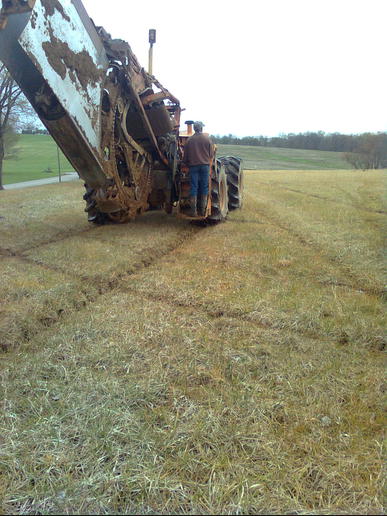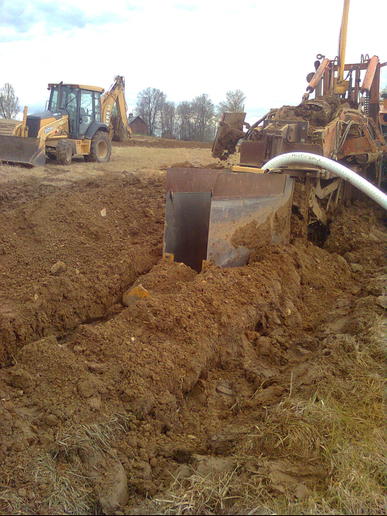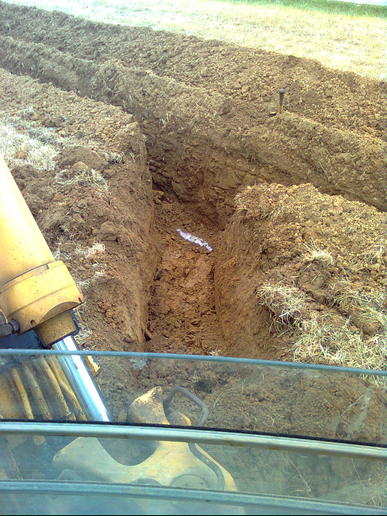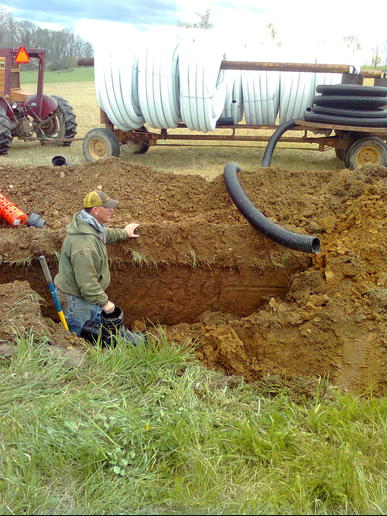I see it mentioned here often but have no clue how it's done. I have a mental image of something similar to french drains or septic field which seem's insurmountable. In Texas,you shoot the field with transit then move dirt as required to drain with road construction equipment. A 4,000 acre place near me was done in mid 50s still drains as well as my front yard. Want to fill me in?
You are using an out of date browser. It may not display this or other websites correctly.
You should upgrade or use an alternative browser.
You should upgrade or use an alternative browser.
- Thread starter da.bees
- Start date
john in la
Well-known Member
I never understood field tiling myself also.
In fact never heard of it till I started talking on internet.
We drain over 60 inches of rain a year off fields threw dirt management and you never hear of farmer waiting for a field to dry to harvest.
Heck they harvest sugar cane everyday during harvest rain or shine.
In fact never heard of it till I started talking on internet.
We drain over 60 inches of rain a year off fields threw dirt management and you never hear of farmer waiting for a field to dry to harvest.
Heck they harvest sugar cane everyday during harvest rain or shine.
My grandfather"s farm was tiled by hand in the early 1900s...two local guys made their living by digging trenches and installing foot-long clay tiles, about 4 inches in diameter. Generally trenched from the middle of a pothole, to an outlet in a lower area. In the 50s it was common to use trenchers, backhoes, excavators, etc. Later, concrete tile was used. In the 80s, we started using plastic perforated til, and when going thru sandy or silt areas, where dirt could seep thru the holes, a net mesh "sock" was installed around the tile. Typically, trenchers (on tracks) were used. Now tile is usually put in with a tile plow, with grade maintained by a laser system. "Intellislope" (google it) brand system lets you drive over the proposed route, and automatically controls grade on the return trip.
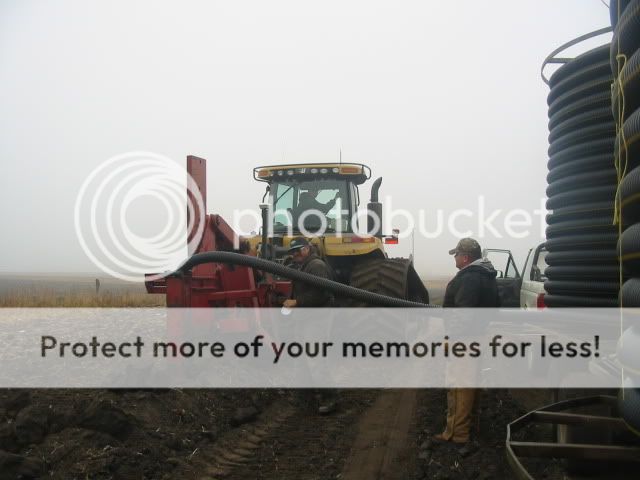

Roger Tomfohrde
Member
Sounds like it is flat ground where you are at. Tiling works if you have a lower spot or ditch to drain to. Our farm there was only one 2 acre flat field, everything else had slope and was contour plowed with the slope. Tile was buried 4 feet to 5 down and had a low spot usually a ways off. A six inch(or larger) plastic or cement line usually with two lines as close as possible to the wet area going down hill. Flatter ground is pattern tiled every 500 or so feet apart, if the line is trenched in, closer together if the line is put in with a plow.There are u-tube videos. Not all farms are wet but we had wet spots on the top of very hilly ground with some 10 percent slope.
coonie minnie
Well-known Member
It is kind of like a septic field... tile is placed usually 30-36 in deep or so, and usually on some kind of pattern. In my neighborhood, 4 in tile on 50 ft centers is common. In some situations, it is spaced more closely.
The entire system is put in so it slopes and drains, of course. In the old days, the tile was put in with a long handle shovel. No kidding. Today, it can be installed with a trencher, a "wheel machine", or plowed in with a tile plow, which is basically a big subsoiler se up to put the tile in right behind the tooth. Plowing is probably the most common method now, especially with the advent of GPS and other sophisticated depth control systems.
The entire system is put in so it slopes and drains, of course. In the old days, the tile was put in with a long handle shovel. No kidding. Today, it can be installed with a trencher, a "wheel machine", or plowed in with a tile plow, which is basically a big subsoiler se up to put the tile in right behind the tooth. Plowing is probably the most common method now, especially with the advent of GPS and other sophisticated depth control systems.
Here's a couple tiling rigs used to put in field tile. A lot of bigger farmers are buying the tractor mounted plows to do their own. Most of the tiling contractors use a crawler mounted tile plow. You have a main you put down, like a 8, 10, or 12" main, then dig down with a backhoe to where the main is with every string of drain tile, then you connect each string to the main. The main runs to where the water flows to, whether it be a ditch, wetland, low hole, pond or a pit with pump. I think normal tile spacing is 30 rods???? Some of these other guys know better than I do. My dad started out of high school laying clay tile. Clay tiles were 16 or 18" long, and had to be hand laid onto the machine to put them together and into the ground.
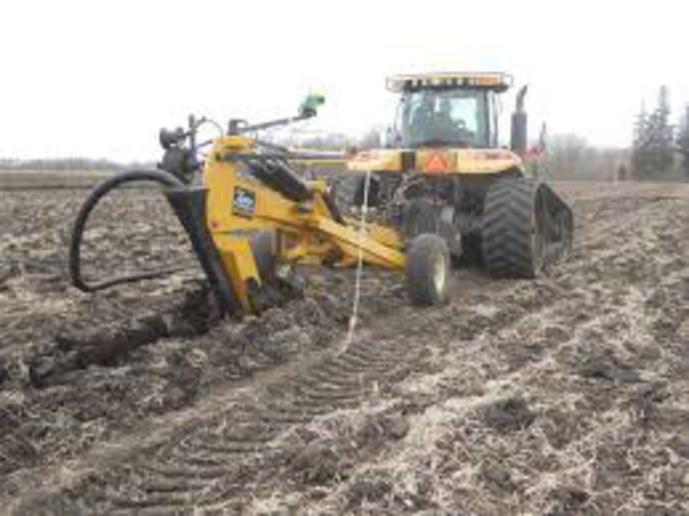
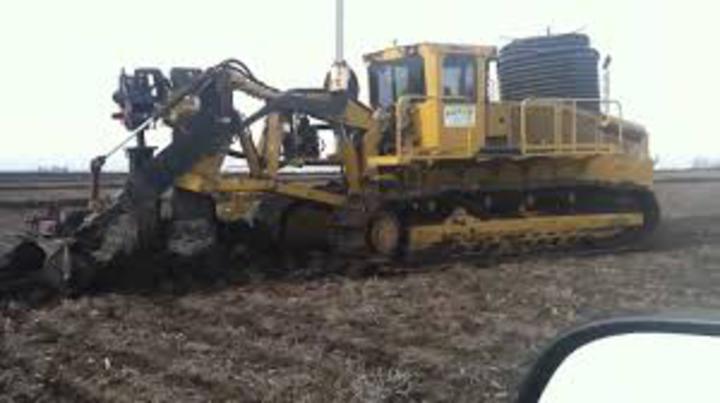
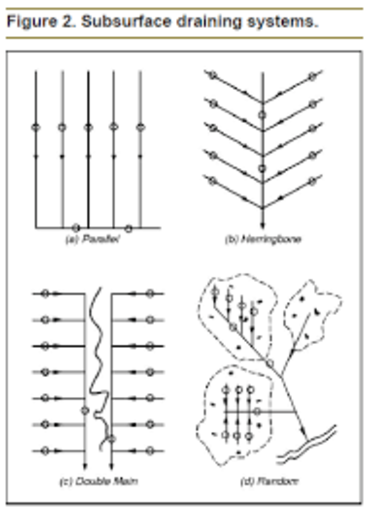
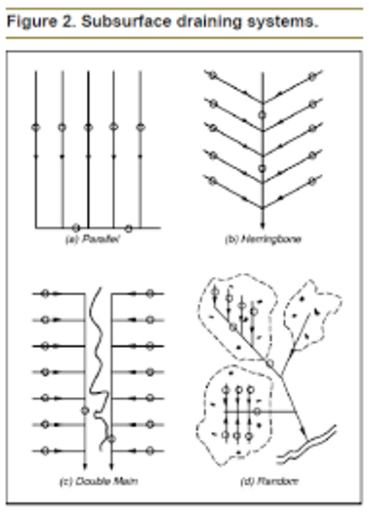




There has to be something we aren't understanding. In areas where tile is common,do many people "grade the surface" instead? At 3 feet below surface,seem's like pipe would be quickly ruined from weight of farming equipment. Even in fields that drain well we occasionally must switch to extra large tires(commonlly called"floatation)to hearvest. Getting seed in is by far harder to work around than hearvest. This is straying from the topic but predicting availability of crop insurance is among reasons corporate farming wear's out small operations around here.
Some tile is as deep as 6' depending on the lay of the land. I've also seen it as shallow as 18" in certain spots, which is definitely not ideal. You have to be sure not to run a ripper through it. But, the tile is corrugated, or ribbed, and is very, very strong and resistant to crushing, but it is possible. Obviously, the more soil over it, the stronger it is. No need for special tires.
J. Schwiebert
Well-known Member
Here in what was the great black swamp tile are a necessity. Most tile are 4 inch and now are placed on 30 foot centers or less. The main tile is called the "outlet" and is run first and the other tile are tapped into it.
da.bees: The tile lines are used in more loam type soils than what your used to. The internal water holding capacity of these soils is higher than your soils. The tile actually lowers the water content of the top 3-4 feet of soil making there be more oxygen and microbe activity.
In my part of Iowa here the tile is used to remove water while the surface is contoured to retain the soil on the slopes we have. So you will have terraces with stand pipes to allow the surface water to quickly drain from the top side of the terraces. I have seen the yield difference be as high as 50 BPA in the right year. Too much water can limit the yield just as too little does.
In the flatter parts of Iowa you have pattern tiling done so the soil does not stay saturated with water thus limiting yields.
In my part of Iowa here the tile is used to remove water while the surface is contoured to retain the soil on the slopes we have. So you will have terraces with stand pipes to allow the surface water to quickly drain from the top side of the terraces. I have seen the yield difference be as high as 50 BPA in the right year. Too much water can limit the yield just as too little does.
In the flatter parts of Iowa you have pattern tiling done so the soil does not stay saturated with water thus limiting yields.
gene bender
Well-known Member
Length is not a problem depends on the field tiles in our areas can be 1/4 mi long or ore
There is no possible way to grade the rolling hills I farm. Fields go up and down several times, 20-100 feet, across an 80.
The clayish slightly loam soils we have are old lake bottoms from when the glaciers melted.
They still hold water, saturated, for several months or more of the year. Several of my soil types are described as saturated, with the water table level with the ground.
We use tile to create a 2-3 foot area of good moist soil, without the totally saturated deal. Lower the water table a couple feet. Leveling the ground really would be pointless, it still would be saturated, totally wet? Sidehills can be the worst, they ooze out like springs for months.
Tile is dug or knifed in about 80 feet apart here, in the wet spots. The ditches and main tiles were put in in the 50s and 60s around here, back into the 1920s in some neighborhoods.
Dad and grandpa had about 50% of this farm in hay to feed the horses, ground was too wet to farm back when. No horses now, tile lets me farm 90% of the ground and raise good crops.
Had a miserable wet year this year, rained every 48 hours, terrible. Ending up with a reasonably good crop, good yields, despite all that. I'd have very little to harvest tho without the tile.
Paul
The clayish slightly loam soils we have are old lake bottoms from when the glaciers melted.
They still hold water, saturated, for several months or more of the year. Several of my soil types are described as saturated, with the water table level with the ground.
We use tile to create a 2-3 foot area of good moist soil, without the totally saturated deal. Lower the water table a couple feet. Leveling the ground really would be pointless, it still would be saturated, totally wet? Sidehills can be the worst, they ooze out like springs for months.
Tile is dug or knifed in about 80 feet apart here, in the wet spots. The ditches and main tiles were put in in the 50s and 60s around here, back into the 1920s in some neighborhoods.
Dad and grandpa had about 50% of this farm in hay to feed the horses, ground was too wet to farm back when. No horses now, tile lets me farm 90% of the ground and raise good crops.
Had a miserable wet year this year, rained every 48 hours, terrible. Ending up with a reasonably good crop, good yields, despite all that. I'd have very little to harvest tho without the tile.
Paul
No French drains, we can't even use regular septic systems here, the ground does not perk, and is so saturated much of he year, there would be no place to drain to.
All tile runs to bigger tile, runs to dig ditches, runs to natural creeks and rivers.
Our subsoil is wet, soaking wet, no place for water to go.
We get heavy snows and frost goes 4 feet deep, as the snow melts and the ground thaws out in spring, the subsoil gets heavily charged with water and pretty much stays totally soaked through typical heavy spring rains well into mid June or July.
Way, way too much water onto soils that perk very slowly, with hills and dips that won't dry out.
Paul
All tile runs to bigger tile, runs to dig ditches, runs to natural creeks and rivers.
Our subsoil is wet, soaking wet, no place for water to go.
We get heavy snows and frost goes 4 feet deep, as the snow melts and the ground thaws out in spring, the subsoil gets heavily charged with water and pretty much stays totally soaked through typical heavy spring rains well into mid June or July.
Way, way too much water onto soils that perk very slowly, with hills and dips that won't dry out.
Paul
Ken Macfarlane
Well-known Member
That would be nice to have that type of soil. Here we use tile but interestingly nearby the French farmers used pattern ditching. All fields were broken up into narrow strips (maybe 66ft?) and plowed in for years to create slope to the ditches. The ditches drain into larger ditches and streams. Now they use excavators to clean the ditches digging to 3-5 ft in the primary to the subsequent ones. Works well but terrible to farm with large equipment.
K Effective
Well-known Member
I learned back in school that some areas in the Thumb region of Michigan lie below sea level, much like areas of Louisiana. The water is pumped out Spring and Fall for planting and harvest, and pumped in during growing season for plant needs. With four distinct soil types across our tiny 50 acre home place, we use tiling to make the wetter areas easier to farm. I would love to peel back the four feet of black muck down in the low spot, push in the sand and gravel from the nearby hill to grade them both, and cover it all in a foot of muck. One farmer nearby did just that on a farm for vegetables, and I heard he spent $5-6K per acre and a whole season to do so. Outside of my budget, plus there are all those grape plants on the hill, with posts and wires, etc. But it is fun to daydream while riding the mower, or such.
Every soil and slope is different.
Patten tile here can be 80 feet apart. Some go as close as 40. In very tight clay soils I hear 30 is common.
Dad did some at 140 apart, that didn't really do the job, too far apart.
Shallow tile, 30 inches or less, will drain faster, but do not drain as wide an area. Tile drain a shallow V the farther away from the tile, the water stays a little higher in the ground. My soil types they suggest the tile will drain 90 feet away from it if you are 3-4 feet deep. At 2-3 feet deep it will pull 75-80 feet away.
If you go deeper than 4 feet, the drainage is very slow. The water does not perk very fast here, and while a 5 foot deep tile will drain a wide area, it will take weeks to do so. That doesn't really accomplish much.
Some of my best draining ground now, is where dad put in the shallow, 24-30 inches deep, 140 feet apart tile. A few years ago we put in a new main 2 feet deeper toget back to some other wet spots, and put in new laterals between the 140 foot. So now I have a pattern tile setup with every other tile 2.5 feet deep, and 4 feet deep, 70 feet apart. The shallow tile drain fast to get surface water sucked down, and the deeper tile pull out the excess ground water deeper over time, making room for more roots, and more water to soak in on the next rain event. What a nice peat muck field that is now! Grows corn like you wouldn't believe.
Before dad tiles it, it was a wet mess he hardly ever harvested more seed than he planted on it. With his shallow distant tile, he was able to plant and harvest it, but the roots were so waterlogged it only yielded half of a normal crop.
This year it rained every 2 days, twice the beans on it were under water (as in 3 feet of water....), but they ended up in my top 5 yields ever, that pattern tile kept them growing, got the water off thrm fast enough, and got the saturated soil dried down good enough to keep the roots happy.
Paul
Patten tile here can be 80 feet apart. Some go as close as 40. In very tight clay soils I hear 30 is common.
Dad did some at 140 apart, that didn't really do the job, too far apart.
Shallow tile, 30 inches or less, will drain faster, but do not drain as wide an area. Tile drain a shallow V the farther away from the tile, the water stays a little higher in the ground. My soil types they suggest the tile will drain 90 feet away from it if you are 3-4 feet deep. At 2-3 feet deep it will pull 75-80 feet away.
If you go deeper than 4 feet, the drainage is very slow. The water does not perk very fast here, and while a 5 foot deep tile will drain a wide area, it will take weeks to do so. That doesn't really accomplish much.
Some of my best draining ground now, is where dad put in the shallow, 24-30 inches deep, 140 feet apart tile. A few years ago we put in a new main 2 feet deeper toget back to some other wet spots, and put in new laterals between the 140 foot. So now I have a pattern tile setup with every other tile 2.5 feet deep, and 4 feet deep, 70 feet apart. The shallow tile drain fast to get surface water sucked down, and the deeper tile pull out the excess ground water deeper over time, making room for more roots, and more water to soak in on the next rain event. What a nice peat muck field that is now! Grows corn like you wouldn't believe.
Before dad tiles it, it was a wet mess he hardly ever harvested more seed than he planted on it. With his shallow distant tile, he was able to plant and harvest it, but the roots were so waterlogged it only yielded half of a normal crop.
This year it rained every 2 days, twice the beans on it were under water (as in 3 feet of water....), but they ended up in my top 5 yields ever, that pattern tile kept them growing, got the water off thrm fast enough, and got the saturated soil dried down good enough to keep the roots happy.
Paul
We have topsoil over a yellow clay subsoil and then a blue clay deep subsoil, pretty much 130 feet deep or so of mostly clay soil going down.
Water does not move through that but at a snails pace.
It takes a month for a 4 inch rain to soak away here, and that assumes not much rain during that month.....
On hillsides the water will go through the topsoil, hit the clay, and flow down the hillside on the clay layer. It is sort of like having a layer of plastic under your topsoil? The water hits it and flows sideways. So any ripple or soil changes on the sidehill will cause that water to flow out and to the surface, creating a long lasting bad wet spot in the middle of a hill.
Water just doesn't soak down much here. They say our drinking water from 200-300 feet deep wells has probably been 100 years since it last saw daylight.
Paul
Water does not move through that but at a snails pace.
It takes a month for a 4 inch rain to soak away here, and that assumes not much rain during that month.....
On hillsides the water will go through the topsoil, hit the clay, and flow down the hillside on the clay layer. It is sort of like having a layer of plastic under your topsoil? The water hits it and flows sideways. So any ripple or soil changes on the sidehill will cause that water to flow out and to the surface, creating a long lasting bad wet spot in the middle of a hill.
Water just doesn't soak down much here. They say our drinking water from 200-300 feet deep wells has probably been 100 years since it last saw daylight.
Paul
He"s an older farmer, near Raymond, MN. I should have his address yet. Here"s another pic...I also drew up detailed plans, and bought steel for, a more stout plow, using the same principle to raise/lower the boot. Didn"t build it, since I"ve hired all the tiling I need. Either plan is for install as you describe, with no automatic grade determinant. Vertical cyl moves the boot up/down in a steel tube.


BarnyardEngineering
Well-known Member
- Location
- Rochester, NY
A tile plow would never work in our soil. Around here a chain or wheel trencher would be the most common installation tool, but an excavator works the best. The only thing about excavators is they require a man in the trench to lay the tile.
Our soil is variable with lots of rocks and veins of gravel. The ground water likes to follow these veins of gravel up to the surface, creating a wet spot. You need to dig down to the gravel vein and lay the tile right in it to divert the water away.
The rocks stop a tile plow in its tracks. Trenchers fare a bit better, but lay the tile at a fixed depth and can't follow the gravel veins to the spring. With an excavator, when you strike water you can follow the spring right to its source and cut it off, as long as you have an inch of fall in 100'. One time we buried a tile about 9' deep, and the vein was still going deeper but the operator made us quit for fear of a cave-in.
Our soil is variable with lots of rocks and veins of gravel. The ground water likes to follow these veins of gravel up to the surface, creating a wet spot. You need to dig down to the gravel vein and lay the tile right in it to divert the water away.
The rocks stop a tile plow in its tracks. Trenchers fare a bit better, but lay the tile at a fixed depth and can't follow the gravel veins to the spring. With an excavator, when you strike water you can follow the spring right to its source and cut it off, as long as you have an inch of fall in 100'. One time we buried a tile about 9' deep, and the vein was still going deeper but the operator made us quit for fear of a cave-in.
These guys build and lay their own pipe. They were in South Carolina this summer trenching tile(they own the company that builds the trenchers)
C&L Tiling
C&L Tiling
newfarmer9
Member
Around here (SouthWestern Ontario) if you don't tile you won't have much of a crop. I've seen in a lot of cases double the yield on tiled ground vs. not tiled.
We tile runs at 30' apart the length of the field and connect them in to a main that then drains in to a ditch. We don't use any kind of surface drainage, moving water across the surface would cause terrible soil erosion here.
The tile underground does not break often. If done properly tile should last several decades. We have some old clay tiles put in in the 1960s that still work fine. Modern tiling is done with plastic tiles.
We tile runs at 30' apart the length of the field and connect them in to a main that then drains in to a ditch. We don't use any kind of surface drainage, moving water across the surface would cause terrible soil erosion here.
The tile underground does not break often. If done properly tile should last several decades. We have some old clay tiles put in in the 1960s that still work fine. Modern tiling is done with plastic tiles.
That is the way I feel it should be done, no tile plows. With that outfit if you find any tiles that were installed years ago and are still working, mot will be, you will hook them back up again to keep working along with the new tile. With the plow you will not find or know where the old working tiles are and so that might make blowout holes.
Similar threads
- Replies
- 48
- Views
- 2K
- Replies
- 18
- Views
- 3K
- Replies
- 39
- Views
- 3K
We sell tractor parts! We have the parts you need to repair your tractor - the right parts. Our low prices and years of research make us your best choice when you need parts. Shop Online Today.
Copyright © 1997-2024 Yesterday's Tractor Co.
All Rights Reserved. Reproduction of any part of this website, including design and content, without written permission is strictly prohibited. Trade Marks and Trade Names contained and used in this Website are those of others, and are used in this Website in a descriptive sense to refer to the products of others. Use of this Web site constitutes acceptance of our User Agreement and Privacy Policy TRADEMARK DISCLAIMER: Tradenames and Trademarks referred to within Yesterday's Tractor Co. products and within the Yesterday's Tractor Co. websites are the property of their respective trademark holders. None of these trademark holders are affiliated with Yesterday's Tractor Co., our products, or our website nor are we sponsored by them. John Deere and its logos are the registered trademarks of the John Deere Corporation. Agco, Agco Allis, White, Massey Ferguson and their logos are the registered trademarks of AGCO Corporation. Case, Case-IH, Farmall, International Harvester, New Holland and their logos are registered trademarks of CNH Global N.V.
Yesterday's Tractors - Antique Tractor Headquarters
Website Accessibility Policy




